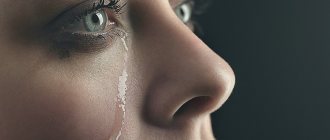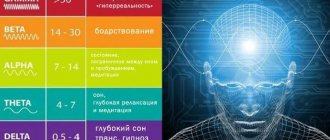“I have apathy” - how often can you hear this phrase from those around us. Everyone has moments in life when they don’t want to do anything, there’s no need for communication, and nothing around them makes them happy. There is only one desire - to lie down, curl up in a ball, so that no one touches or bothers you.
Before asking the question of how to get rid of apathy, you need to know what it is, its types, symptoms, causes. Someone will smile, but in vain. Apathy is a disorder of a person’s mental health; it does not just arise out of nowhere. If this condition does not last long, then there is nothing to worry about. It is much worse if the illness becomes protracted and, which is very dangerous, gradually develops into a severe form of depression. And in this case, only a qualified specialist can advise you on how to deal with apathy. You shouldn’t risk your health and wait – the consequences can be unpredictable!
Competition “Bio/Mol/Text”-2020/2021
This work was published in the “Free Topic” category of the “Bio/Mol/Text” competition 2020/2021.
The general partner of the competition is the annual biotechnology conference BiotechClub, organized by the international innovative biotechnology company BIOCAD.
The sponsor of the competition is SkyGen: a leading distributor of life science products on the Russian market.
Competition sponsor: the largest supplier of equipment, reagents and consumables for biological research and production.
"Book" sponsor of the competition - "Alpina Non-Fiction"
We often hear that social networks are to blame for everything: “Teenagers do not part with their phones, they sit on them day and night! And then they can’t wake up for school, they fall asleep in class, and because of this they study poorly. Then on weekends they sleep until noon, but the lessons won’t teach themselves. Okay, if they want to go to bed late, then let them read books, because it’s this blue light from the screens that keeps them awake for so long!”
Do you recognize the arguments? But some of them are myths, while the significance of others is exaggerated. In reality, why we sleep and how we do it at different times in our lives is a complex and contradictory story. Let's try to figure out why the sleep of teenagers and young adults is so different from the sleep of middle-aged people and children, why we don't get enough sleep all the time (even if we sleep for what seems like a sufficient amount of time), what role does the first class/first lesson at 8 play in this? :30 in the morning, and what - hanging out on social networks at night, looking at it, and let's talk about whether something can be done about all this.
What are the dangers of emotional burnout?
Due to emotional burnout, people cease to understand why they do the work, and most importantly, why they do it well. This is a problem not only for the “burnt out” person, but also for those people who interact with him: we are faced with cynical doctors, psychologists incapable of empathy, aloof teachers. We don't get the help we asked for because they are no longer able to provide it.
For those who are “burned out,” the quality of life is greatly reduced: they feel incompetent, doubt or deny achievements, feel tired and believe that they are unable to influence anything.
“Against the background of emotional exhaustion, physical fatigue begins to accumulate, and all this can lead to psychosomatic diseases. There may be pain in the neck or back, head, stomach, stabbing in the side or under the heart - in general, any pain is possible in a wide variety of manifestations. People go to hospitals, undergo all sorts of tests, but they don’t find a reason - it doesn’t exist at the physical level. Psychosomatic manifestations are more characteristic of people with idealistic expectations: a person simply waits for something to happen that will save him,” says Veronika Pivkina.
She also noted that among her clients there were no ones who complained specifically about emotional burnout. This situation may persist throughout the country, because people usually come to a specialist in critical situations when they cannot do anything themselves. When it doesn’t really matter whether the problems really started with burnout, and it’s more important to figure out what the person is doing wrong and how it can be corrected.
A perfect storm
The map for us will be the model of a “perfect storm” (a perfect storm, an English phraseological unit denoting an event in which a rare combination of circumstances sharply aggravates the events) (Fig. 1) [1], [2]. This is a model according to which, in adolescence, sleep is influenced by physiological and social factors: on the one hand, shifting it in time, on the other, reducing its duration. This subsequently affects well-being, mood, academic performance and can cause health problems.
Figure 1. The “perfect storm” model.
[2]
What is emotional burnout?
The concept of “emotional burnout syndrome” was introduced by the American psychiatrist Herbert Freudenberger in 1974. It describes the state of demoralization, frustration and extreme fatigue that Freudenberger observed among mental health workers.
Emotional burnout is a state of increasing emotional, motivational, and physical exhaustion, which is accompanied by a feeling of emptiness and helplessness, a cynical attitude towards work and other people. This is a defensive psychological reaction in which the manifestation of emotions to those influences that can hurt or traumatize a person is “turned off.” This is how the body protects itself from excessive overload and forces us to dose and save energy resources.
Physiological factors
With the onset of puberty, a biologically determined shift in the sleep-wake cycle occurs, with a tendency toward falling asleep later. This shift is mediated by at least two reasons.
Firstly, there is melatonin. It determines our bedtime, and its synthesis follows the circadian rhythm. As the child grows older, the peak of its secretion shifts to a later time, from approximately 10:00 pm to 1:00 am. In addition, the volume of its synthesis decreases significantly, and in girls these changes occur earlier than in young people, as does the onset of puberty [2], [3].
What circadian (aka circadian) rhythms are can be learned from the article “Biomolecules” about the Nobel Prize in Physiology or Medicine for 2022 [4].
In addition, it is melatonin that synchronizes our internal biological clock with the time of day: its secretion changes depending on the activity of the suprachiasmatic nucleus, which, receiving signals from the retina, responds to changes in ambient light. Sensitivity to evening light levels increases in early adolescence [5]. This leads to suppression of melatonin secretion and, as a consequence, a delay in falling asleep [6].
You can learn more about the work of the suprachiasmatic nucleus from the article “Biomolecules” : “Wake up!” - “Go to sleep...” - “Wake up!” - “Go to sleep...” - “Wake up!” [7].
The second reason is a delay in the phase of the sleep-wake cycle during adolescence. And this is not a disease of modern society and city residents. This phenomenon is noted regardless of the significant cultural differences in the habits of adolescents in different countries around the world [8]. In order to understand it, we first need to become familiar with the two-component model of sleep regulation (Figure 2). It is based on the interaction of two components—the circadian and homeostatic processes of sleep regulation [9], [10]. The circadian process (C-process) is rhythmic, its cycle is approximately 24 hours and is regulated by the level of light at different times of the day, the activity of the suprachiasmatic nucleus and melatonin. The homeostatic process (S-process) is associated with the accumulation of fatigue and drowsiness during wakefulness; it increases during the day and decreases during the night. Its marker is considered to be the delta index (also known as the SWA level, slow-wave activity on the electroencephalogram, EEG). In healthy people, it is maximally expressed during slow-wave sleep (NREM sleep), increases depending on the duration of previous wakefulness, and is extremely high during sleep deprivation.
Figure 2. Two-component model of sleep regulation.
[9], [10]
This “sleep pressure” (homeostatic S-process) accumulates more slowly in adolescence, which is associated, among other things, with a decrease in the peak level of melatonin and leads to a longer time to fall asleep, forcing one to stay awake at night (Fig. 3). At the same time, this “pressure” decreases in adolescents almost as slowly as in children. Thus, given the need to wake up early the next day, the 8–10 hours of sleep required for adolescents turns out to be an almost impossible condition in their usual reality [11]. It is worth noting that the listed processes increase with growing up and puberty, so high school and junior students experience the greatest difficulties with short and poor-quality sleep [12], [13].
Figure 3a. Levels and timing of melatonin secretion in adolescents at different stages of sexual development.
[12]
Figure 3b. “Childhood” and “teenage” patterns of the sleep-wake cycle. The red and blue lines are the upper and lower boundaries of the circadian process (C-process), which indicate the threshold for falling asleep and the threshold for waking up. The green line is the homeostatic process (S-process).
[13]
How exactly these features are programmed at the genetic level is still unknown, but there are studies on fruit flies. For example, the pdm3 gene was discovered, which is necessary for the formation of sleep regulation mechanisms in Drosophila. This gene encodes the protein PDM3, a transcription factor domain that coordinates the early brain development program and controls the communication of wakefulness-promoting dopaminergic neurons with the sleep-promoting region. When the pdm3 gene is knocked out, dopaminergic inhibition of the sleep center increases prematurely, its formation is disrupted, and young flies continue to stay awake when they should fall asleep, thereby not getting the required amount of sleep. There are a number of homologous genes in humans, one of them is POU6F2. In mammals, its products, the POU proteins, are associated with neurodevelopmental disorders such as autism spectrum disorder, which are often accompanied by comorbid sleep disorders, suggesting a potential role for these early life sleep regulators [14]. Thus, we have little evidence that the shift in the sleep-wake cycle is genetically determined and occurs with maturation and brain development.
You can learn about another “sleep gene” discovered in fruit flies from the 2008(!) news on Biomolecule [15].
We cannot influence all this biological machinery, but the second group - social factors, which are associated with most misconceptions and myths - is quite amenable to modification.
Social factors
As we have already figured out, from a physiological point of view, social networks and the cold light of screens associated with them are not the only culprits of late bedtime. Of course, an active social life attracts our attention to countless chats, but it is not entirely clear: this is the reason for going to bed late or a way to fill the time in which, on the one hand, you are no longer productive enough to study, and on the other, not yet so Do you want to sleep to put off all your work? In addition, there is no consensus in the scientific community about which element of sleep hygiene has the greatest impact, and therefore there are no direct recommendations from international sleep medicine and pediatric organizations regarding the use of gadgets before bed [16], [17].
Other social factors that influence teens' sleep include academic workload and peer pressure. For some, it may be the fear of failing an upcoming exam, forcing them to study all night long; for others, it may be difficult relationships with teachers or classmates that are disturbing and do not allow them to sleep. In both cases, a vicious circle is formed: problems at school can lead to anxiety, insomnia and lack of sleep, which, in turn, reduces cognitive function the next day, adds irritability and impulsivity, and therefore new problems appear that interfere with sleep.
Another factor (it can be called sociobiological) is the consumption of caffeine in general and coffee in particular. In the eyes of many teenagers, this is one of the ways to appear older by drinking a kind of “growing up drink.” But for teenagers, the daily caffeine intake is much lower than for adults; it is easy to exceed it, focusing on parents, and as a result - tachycardia, hand tremors and increased anxiety, which in no way contribute to healthy sleep [18].
Above we mainly talked about going to bed late. But its duration is limited by the time at which we need to wake up, and few of us do this without an alarm clock (and more often than not without several at intervals of “five more minutes”). The first and main requirement of society for teenagers - studying at school, college or university - is inextricably linked with the early time of waking up (at 6-7 in the morning) for the first lesson. This mismatch between the physiological need for a particular sleep-wake schedule and social demands is the cause of chronic sleep deprivation, the “perfect storm” that plagues adolescents every day and every night. In the evening, sleep is interrupted by minutes of delay in the phase of the sleep-wake cycle, a slow increase in sleep pressure, social and academic problems, and in the morning by the early start of classes, which makes healthy sleep (one of the basic human needs!) unattainable.
The graph shows a strict limitation of sleep time by social factors (Fig. 4) [19]. With the onset of adolescence, sleep time on Saturday and Sunday begins to differ significantly from that on weekdays: getting up and falling asleep later, sleeping longer on weekends is not a sign of laziness, but an attempt to enter a biologically necessary mode after lack of sleep during the work week. And this attempt is not very successful: two nights of full sleep are simply not enough for recovery. The study, conducted by researchers at the Center for Cognitive Neuroscience in Singapore, involved adolescents who slept 9 hours each in the first control week, 5 days of 5 hours each in the second test week, and then 2 days of 9 hours each, reproducing weekdays and weekends [ 20]. Over 5 “weekday” days, the delta index increased and did not return to its original level. As a result, with this regime, lack of sleep becomes chronic with all the ensuing consequences, which we will talk about later.
Figure 4. Average bedtime and wake-up times on weekdays and weekends by age. Adolescents and young adults make up for the sleep time strictly limited by social factors on weekdays on weekends.
[19]
How to deal with emotional burnout?
When fighting burnout on your own, you should be prepared that it will take time. This is more difficult than working with a specialist: it is difficult to objectively assess yourself, your condition, in order to understand exactly where your thoughts and emotions are, and where are the imposed attitudes. It is difficult to move yourself from a negative point, to pull yourself out of a state of indifference, because there may not be enough internal resources for this.
In independent struggle, the psychologist recommends acting in this way:
- Reduce loads. If you have a lot to do at work or at home, then think about who to share them with. You will need time and resources to fight.
- Reduce the level of responsibility. You can ask your loved ones to look after your children and help your colleagues at work. It is important that the responsibility for what is happening does not lie solely with you, especially if it is the responsibility for other people.
- Focus on yourself. Learn to relax: Read about relaxation techniques and find one that suits you. The main thing is to wait until fatigue and indifference subsides.
- Figure out what is important in life and what is not. Analyze what depresses and causes a feeling of meaninglessness and uselessness of work, what emotions you have isolated yourself from, why certain situations occurred.
- Think about how you can influence the situation. First of all, you need to cover basic physical needs, the need for safety. Everything here is individual: someone will need to decide how to increase income, someone will need to change companies, accumulate a financial cushion, and someone will realize that they want to work in a different field.
A psychologist will help you figure it out faster and relieve the person of some of the burden of responsibility, because this way you will work as a team.
Consequences
Clearly, chronic sleep deprivation is a serious problem for both individuals and society as a whole. If you don't solve it, what consequences will it lead to?
I think many are familiar with the short-term ones: drowsiness, problems with performance, bad mood, sometimes anxiety, aggressiveness and impulsiveness [21], [22]. The relationship between mood and sleep is complex and bidirectional because low mood and anxiety can exacerbate insomnia and vice versa [23]. In addition, depressive symptoms can sometimes be improved by increasing sleep duration [24]. Also, with a lack of sleep, criticism of one’s own state and the ability to control emotions decrease, which leads to risky behavior [25–28].
In the longer term, lack of sleep can lead to hormonal imbalance, which, along with overeating, can lead, for example, to obesity - due to increased synthesis of ghrelin, which increases appetite (another episode with another pack of chips?), to type 2 diabetes mellitus , cardiovascular diseases [29–31]. Problems with learning and memory are common—and may be related to the volume of gray matter in the hippocampus (a brain structure traditionally associated with memory processes). In a study of healthy children and adolescents, hippocampal volume was positively correlated with sleep duration [32]. In old age, the risk of dementia increases because it is during sleep that the brain most actively gets rid of metabolic waste products, including beta-amyloid and tau protein, which are associated with neurodegenerative diseases.
You can read more about the connection between sleep and intellectual decline in the Biomolecules “Sleep and Aging II: How does the sleep of the elderly and sick differ from the sleep of the young and healthy?” [33], and about the glymphatic system, which plays an important role in this, in the Naked Science article.
It is unlikely that there will be a person who wants to experience even part of the palette of these consequences for himself, although this list is still far from complete. However, this is exactly the picture we bring ourselves closer to every evening by staying up late and then getting up at 6 am to study or work.
Who experiences emotional burnout?
The main risk group for emotional burnout is people whose work involves great responsibility, strong emotional involvement in the process, and constant contact with people. These are doctors, police officers, firefighters, teachers, psychologists, journalists, and service workers.
At the same time, a person of any occupation can potentially “burn out” if he cares about his business and gives his best for the sake of the result. Psychotherapist Veronika Pivkina says that burnout in any area is facilitated by:
- Delayed result of efforts - a person cannot evaluate his contribution and effectiveness;
- Routine work - a person has to perform the same actions over and over again;
- Lack of feedback in evaluating work: both praise and adequate criticism, assistance in analyzing and eliminating errors;
- Heavy workload and lack of normal rest, especially in areas that require quickly making decisions and studying large volumes of material;
- Lack of proper remuneration for work, proportional to the effort put in by a person: not only material, but also moral.
There is no research on which gender is more prone to burnout: this is an individual reaction. However, discrimination can be an additional factor in burnout: women often encounter it when building a career in almost any field, and especially when getting into leadership positions. In addition to obvious discrimination, there are also limiting stereotypes: there are many of them, and they affect both men and women.
Thus, in the minds of many, it is still customary to divide spheres into male and female: “not a man’s job” to work as a stylist or teacher, “not a woman’s thing” to work as an engineer or programmer. People begin to make great efforts to prove to someone that they are in the right place and doing a good job. And even if a person understands that this is nonsense, these stereotypes can still put pressure on him and contribute to burnout, Veronika Pivkina is sure.
Help yourself
While it is still possible to find a job that you can come to at a comfortable time, rescheduling your first lesson at school is, unfortunately, more difficult. Therefore, taking care of their own health (mental and physical) falls on the shoulders of adolescents themselves. The first thing to remember is sleep hygiene, which, fortunately, has been talked about a lot lately. Here are some principles:
- regular daily routine (same time of going to bed and waking up);
- avoiding bright, cold light half an hour before bedtime. Now on many phones you can set up an evening mode - a warmer and dimmed screen light will turn on automatically at the same time;
- Wake up at the first alarm and immediately turn on bright lights. Sleeping for five minutes does not add vigor.
These small changes can make your life easier and make waking up in the morning a little less unbearable. But there is hope that one day measures will be taken at the global level. For example, in the USA there is a social movement Start School Later in support of later start of classes for high school students [34]. If for our country 8:30 is the standard start time for classes, then in America classes can start even at 7:55! Recently, California passed a law according to which, gradually, by July 2022, classes in all schools will begin no earlier than 8:30.
How can you tell if you have emotional burnout?
Symptoms of emotional burnout are divided into 3 groups:
- Emotional exhaustion: fatigue, feeling of emptiness, indifference to what is happening;
- Depersonalization: cynicism, detachment, difficulty in imaginative thinking, inadequate emotional response towards colleagues, clients, patients;
- Reduction of professional achievements: a feeling of incompetence and helplessness, dissatisfaction with work, doubts about one’s contribution to work and achievements.
If you observe such symptoms, you can test yourself using the Boyko test and the Maslach-Jackson questionnaire (MBI).











